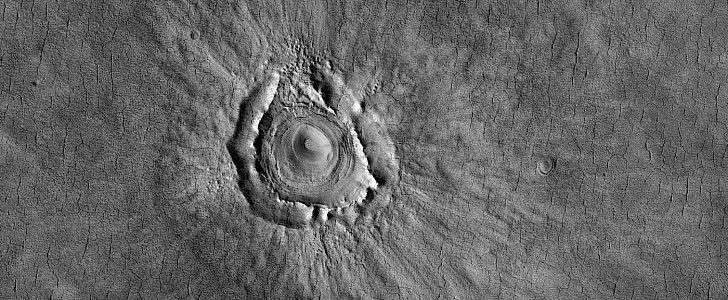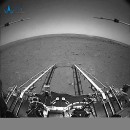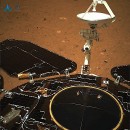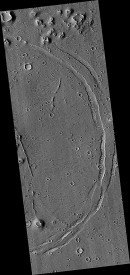Nature is a very creative force. So much so, that even when it destroys things, in cahoots with its favorite sidekick, time, it does so with such style and imagination that oftentimes what remains can be seen as some form of art.
Just look at the main photo of this piece. You can’t tell, really, but what you’re looking at is an impact crater on the surface of Mars (yes, nature does its thing there as well) that looks strangely symmetrical, artificial even, like some sort of planetary nipple placed on the surface of the planet by a minor artist born on the neighboring planet.
What we’re seeing is not made by Martians, of course, but by the nature we mentioned earlier. It was responsible for hurtling an asteroid towards the Red Planet’s surface. It impacted in the Utopia Planitia region, but it left behind a kind of crater we don’t usually get to see.
According to the people over at NASA and the University of Arizona, who study the photos sent back by the HiRISE camera in orbit around the planet, the strange shape of the crater is due to it’s relatively young age. We’re not told when the asteroid might have hit this place, but researchers do know it’s fresh judging by the bright rays and ejecta that make for the said nipple and the surrounding edges.
There is something not quite right about this feature. As NASA says, without trying to explain itself, the crater seems to be “heavily (and strangely) modified.” That, of course, does not mean it suspects an intelligence at work here, only that further study is needed to “understand what processes are at work here.”
The photo was captured by HiRISE from an altitude of 300 km (196 miles) back in 2020, and only recently published by the University of Arizona.
What we’re seeing is not made by Martians, of course, but by the nature we mentioned earlier. It was responsible for hurtling an asteroid towards the Red Planet’s surface. It impacted in the Utopia Planitia region, but it left behind a kind of crater we don’t usually get to see.
According to the people over at NASA and the University of Arizona, who study the photos sent back by the HiRISE camera in orbit around the planet, the strange shape of the crater is due to it’s relatively young age. We’re not told when the asteroid might have hit this place, but researchers do know it’s fresh judging by the bright rays and ejecta that make for the said nipple and the surrounding edges.
There is something not quite right about this feature. As NASA says, without trying to explain itself, the crater seems to be “heavily (and strangely) modified.” That, of course, does not mean it suspects an intelligence at work here, only that further study is needed to “understand what processes are at work here.”
The photo was captured by HiRISE from an altitude of 300 km (196 miles) back in 2020, and only recently published by the University of Arizona.








